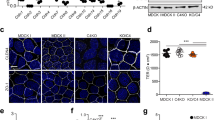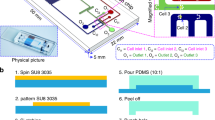Abstract
THE mouse blastocyst contains a fluid-filled cavity, the blastocoele, which in normal Q-strain embryos first appears at about 83 h post coitum, when cleavage has produced a ball of about 30 cells1. Two factors could be involved in the formation of the blastocoele: the secretion of fluid, which seems to be brought about by the coalescence and subsequent release of fluid-filled cytoplasmic vacuoles2, and the development of tight intercellular junctions. Such junctions are first observed at the eight-cell stage, around the periphery of the embryo3; in the blastocyst they have increased in number and complexity to form the so-called ‘zonula occludens’, a permeability seal that can exclude lanthanum tracer from the blastocoele and thus presumably plays a role in maintaining the fluid turgor of the blastocyst4. By ‘immunosurgical’ dissection5 of Q embryos, we have investigated the stage of normal development at which the permeability seal becomes functional. We report here that impermeability to antiserum was not achieved until the mid-blastocyst stage (45–50 cells), and was not hastened or delayed by experimentally increasing or decreasing total cell number.
This is a preview of subscription content, access via your institution
Access options
Subscribe to this journal
Receive 51 print issues and online access
$199.00 per year
only $3.90 per issue
Buy this article
- Purchase on Springer Link
- Instant access to full article PDF
Prices may be subject to local taxes which are calculated during checkout
Similar content being viewed by others
References
Smith, R. & McLaren, A. J. Embryol. exp. Morph. (in the press).
Calarco, P. G. & Brown, E. H. J. exp. Zool. 171, 253–284 (1969).
Ducibella, T. & Anderson, E. Devl. Biol. 47, 45–58 (1975).
Ducibella, T., Albertini, D. F., Anderson, E. & Biggers, J. D. Devl. Biol. 45, 231–250 (1975).
Solter, D. & Knowles, B. B. Proc. natn. Acad. Sci. U.S.A. 12, 5099–5102 (1975).
Izquierdo, L. & Ortiz, M. E. W. Roux Arch. Devl. Biol. 177, 67–74 (1975).
Hillman, N., Sherman, M. I. & Graham, C. J. Embryol. exp. Morph. 28, 263–278 (1972).
Barlow, P., Owen, D. A. J. & Graham, C. J. Embryol. exp. Morph. 27, 431–445 (1972).
Garner, W. & McLaren, A. J. Embryol. exp. Morph. 32, 495–503 (1974).
Horner, D. & McLaren, A. Biol. Reprod. 11, 553–557 (1974).
Cole, R. J. J. Embryol. exp. Morph. 17, 481–490 (1967).
Borland, R. M., Biggers, J. D. & Lechene, C. P. Devl. Biol. 50, 201–211 (1976).
Borland, R. M. in Development in Mammals 1 (ed. Johnson, M. H.) (Elsevier/ North Holland/Biochemical, Amsterdam, 1977).
Whittingham, D. G. J. Reprod. Fert. Suppl. 14, 7–21 (1971).
Bowman, P. & McLaren, A. J. Embryol. exp. Morph. 23, 693–704 (1970).
Tarkowski, A. K. Cytogenetics 5, 394–400 (1966).
Author information
Authors and Affiliations
Rights and permissions
About this article
Cite this article
MCLAREN, A., SMITH, R. Functional test of tight junctions in the mouse blastocyst. Nature 267, 351–353 (1977). https://doi.org/10.1038/267351a0
Received:
Accepted:
Issue Date:
DOI: https://doi.org/10.1038/267351a0
This article is cited by
-
Ultrastructure of mouse blastocysts during blastocoele expansion
Wilhelm Roux's Archives of Developmental Biology (1985)
-
The development of cell junctions during nephrogenesis
Anatomy and Embryology (1981)
Comments
By submitting a comment you agree to abide by our Terms and Community Guidelines. If you find something abusive or that does not comply with our terms or guidelines please flag it as inappropriate.



